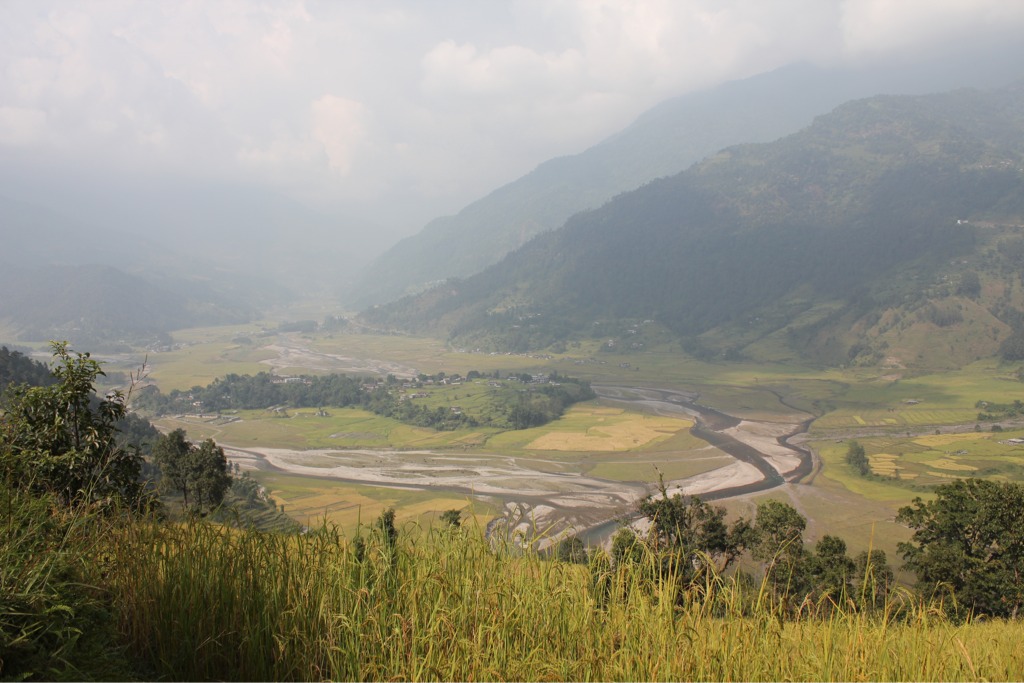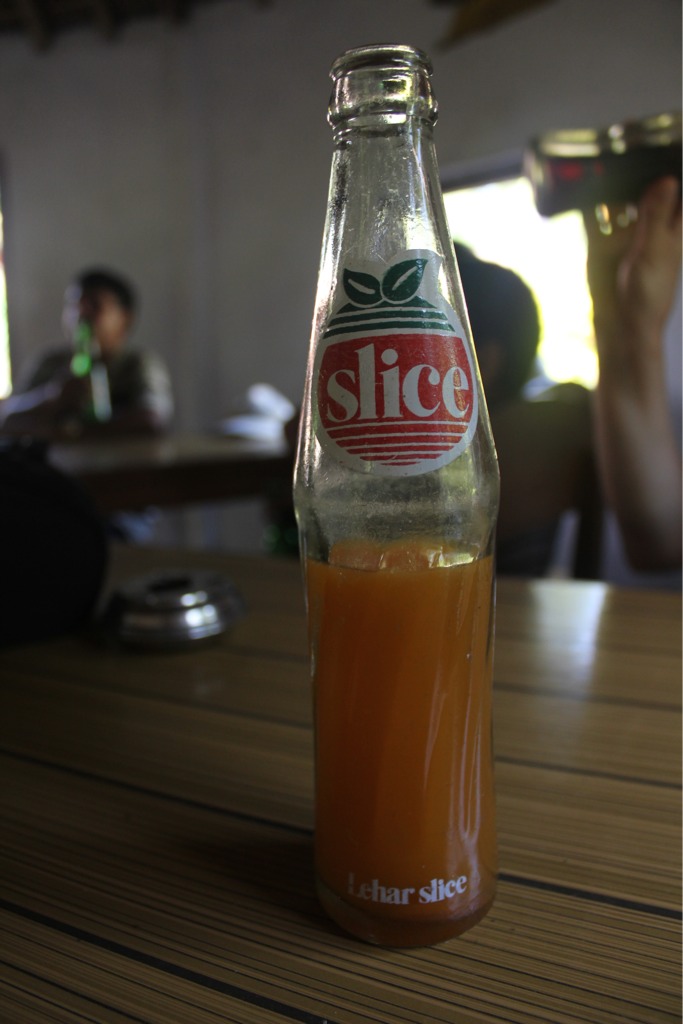After arriving in Pokhara and spending a couple days exploring we set about on a six day trek. Pokhara, which is surrounded by the Annapurna Range, exists almost entirely on this sort of nature based tourism so there was no lack of help finding where to go. In an effort to avoid some of the tourist crowds, we opted for the Mardi Himal Base Camp trek - a newer route that only in the last three to five years has become anything more than a camping, DIY affair. Here are some snippets and observations from our first-hand encounter with the Himalayas: Duration: 6 days Guide: Jhalak

• Jhalak picks us up in Pokhara and we take a taxi towards our starting point. En route, we pick up a just-finished wooden shelf for his kitchen (he had ordered it the week prior and spotted it while passing by the shop). We enjoy chiya on the roof patio, while Jhalak and the taxi driver saw the legs down and jam said shelf into place in the kitchen next to us. Not how we thought we would start the day, but a better way to be introduced to the man that would guide us through the forest for the next six days than we could have expected.
• The hike starts from Kande, a small hillside village. A dog joins us there and will stay with us until our lunch stop.
• Weather for the day is day is mostly hazy with bursts if strong sun. Our backs are soaked through by thirty minutes in.
• An embroidery of a temple adorns the fence across from our dal bhat lunch stop, twisting in the breeze. We never saw another one like it.
• Many stone steps up, up, up. Donkeys with gentle bells, old men wi grass on their heads in flip flops, and a maximum of eight other trekkers pass us on their way down, down, down.
• Bhichuk Deurali, our first stop at 2100 meters, is reached by early afternoon, with only 3.5 hours of hiking behind us. We have a 200 rupee room, several cups of masala chiya, dense cloud cover, and a touch of chill late at night.

• Spectacular sunrise number one. The heavy clouds break, revealing Annapurna South and Dhaulagiri to the north. The trail splits off from here - to the left, Annapurna Base Camp, to the right our path to Mardi Himal.
• Steep uphill climbs through moss laden trees. Magical, surreal. We can practically watch them breathing.
• Lunch at Forrest Camp after 3.5 hours. Long wait for dal bhat made for a good rest. We are joined by a Swiss couple - Nora and Sam, a group of four Germans, and the two guides accompanying them. From here, we will all pass and tail one another on the rest of the trek, becoming a rambling collective.
• Tough to describe the intensity of the constant uphill climb - think unpredictable steps made of rocks and tree roots, sometimes so tall it is more about hoisting up than stepping.
• Rhododendron trees, with low hanging branches and uniform, hearty leaves, make up the bulk of the forest.
• Arrival a Low Camp, approximately 3000 meters, paired with more dense cloud cover and some late evening rain. Super rustic accommodation with peek-a-boo, wood plank walls and dirt floors. Evening brings temperatures cold enough for jackets and hats.
• Eli passes time with some carving, Casey with some reading. Later, we all huddle around the very welcome bonfire, drying our sweaty clothes by hanging them off our knees.
• Dal bhat - after a long, long wait and co-cooked by Jhalak - is eaten from our laps, with smoke in our eyes, and we turn in, exhausted, around 9pm.

• We watched the porters for another group leave with 40kg each on their backs - Converse sneakers on their feet - while the sun rose over our previously hidden backdrop of Machhapuchhre.
• As expected, more steep uphill on the three hour ascent to High Camp (elevation approximately 3800 meters) as the vegetation thins out from temperate rainforest to low, thick tufts of grass and small wildflowers.
• One, skunk striped yak encounter. No injuries to report. All is peaceful.
• Early High Camp arrival in far colder weather, prompting the immediate donning of any and all remaining dry layers (including, almost unanimously, a two hour sleeping bag hibernation - warmth and rest. Double win!)
• Still heavier cloud covering, with much more rapid changes. Short breaks of blue sky would be quickly swallowed up as we, quite literally, watched clouds come up one side of the ridge to spill over and down the other, looking much like dry ice.
• Lunch and dinner huddled in the heavily smoke filled kitchen/dining room followed by early bed.

• 5AM alarm puts us outside under the frosty, crisp and clear sky with Machhapuchhre, Annapurna South and Hiun Chuli lit up in the moonlight, shared with our Swiss companions, Nora and Sam.
• 6AM departure towards Mardi Himal Base Camp. High altitude, wet grass, icy moss, and some vertical climbs, all under the pressure of beating the incoming morning cloud cover.
• We stop at MH Viewpoint (~4300 meters), just shy of the Base Camp to avoid some altitude sickness. Spectacular 360° views including the above mentioned peaks as well as Annapurna I, Nilgiri, and several others.
• Back down to High Camp for breakfast by 10AM, completing the first two of six hours of descent for the day. Uralo, uralo, uralo. (Down, down, down.)
• We backtrack to Low Camp via the same tree root steps and branch off from there towards the tiny village of Siding (1900 meters - a one day descent of 2400 meters, for those keeping track), Machhapuchhre again (or still?) sitting front and center.
• Tired legs and delirium set in two hours from our destination. Wobbly knees led to stumbles for Casey and serious relief washed over us when we reached the simple guesthouse nestled on the side of a terraced valley full of rice and millet.
• Incredible dal bhat with garden veggies, minted pickle, and hot buffalo milk. Thank you, Laksmi!

• Wake up weary of more downhill, but masala chiya and remembering to go slow brings calm.
• Through the fields - balancing on the top edge of the terraces, over bridges, past waterfalls. Picking up little stone mementos and slipping them in pockets.
• We are joined for an hour by school children on their way to class, which starts at 10am. Hopping down broad steps, they jet ahead of us and shout hellos and goodbyes.
• Pause for a sit and a soda in Lumre, at the base of the hill. Onward along the road, some noodle soup, and back up never-ending steps towards Astam.
• Visit to Jhalak's aunt. We sip chiya, attempt to finish buffalo buttermilk (unsuccessfully) and play with the baby on the porch. A heap of little kids show up and shyly hang around.
• More climbing, really staggering at this point, up a final path to Astam Eco Village. More highly priced than expected, but by no means expensive. Bio-fuel, rain water collection, beautiful gardens and actual relaxation.
• Feeling accomplished, even with two hours ahead of us for the last day.

• Longest wait for a simple breakfast. It turns out some teenagers were in charge and learning how to cook. All tasted delicious though, so it didn't matter.
• Yes, still shaky legs...but this is eased by the rush of pride from actually finishing.
• We thankfully take the easier way down - a rambling dirt road as opposed to the vertical drop route.
• Hitch a ride to Jhalak's house from the main road, enjoy more dal bhat (thanks to his wife) and play volleyball in the driveway with his two kids and their friend.
• The peace of the mountains in the distance, we are quiet as we re-enter civilization via taxi and witness the bustle, the pollution, the tourists and our own sensations of all of this.

PS. Should anyone reading this find themselves in Nepal and seeking a first rate guide, we wholeheartedly recommend Jhalak. Leave us a comment, or email us if you know us, and we can pass along his phone number!
Location:Pokhara, Nepal
























